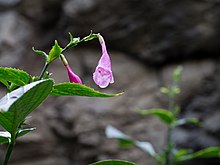
Back قميعة (نبات) Arabic قميعه ARZ Strobilanthes CEB Strobilanthes Spanish قیفیگلها Persian Strobilanthes French Strobilantes Croatian Strobilanthes ID സ്ട്രോബിലാന്തസ് Malayalam Стробилянт MRJ
| Strobilanthes | |
|---|---|

| |
| Strobilanthes species, cultivated in Hawaii | |
| Scientific classification | |
| Kingdom: | Plantae |
| Clade: | Tracheophytes |
| Clade: | Angiosperms |
| Clade: | Eudicots |
| Clade: | Asterids |
| Order: | Lamiales |
| Family: | Acanthaceae |
| Subfamily: | Acanthoideae |
| Tribe: | Ruellieae |
| Genus: | Strobilanthes Blume |
| Species | |
| Synonyms[1] | |
|
List
| |

Strobilanthes is a genus of about 350 species[2] of flowering plants in the family Acanthaceae, mostly native to tropical Asia and Madagascar, but with a few species extending north into temperate regions of Asia. Many species are cultivated for their two-lipped, hooded flowers in shades of blue, pink, white and purple. Most are frost-tender and require protection in frost-prone areas.[3] The genus is most famed for its many (but not all) species which bloom on long cycles of several years, such as Strobilanthes wightii which blooms every thirteen years.[4]
- ^ "Strobilanthes Blume". Plants of the World Online. Board of Trustees of the Royal Botanic Gardens, Kew. 2017. Retrieved 9 December 2020.
- ^ Moylan, Elizabeth C.; Bennett, Jonathan R.; Carine, Mark A.; Olmstead, Richard G.; Scotland, Robert W. (2004). "Phylogenetic relationships among Strobilanthes s.l. (Acanthaceae): evidence from ITS nrDNA, trnL-F cpDNA, and morphology". American Journal of Botany. 91 (5). American Journal of Botany, Inc.: 724–735. doi:10.3732/ajb.91.5.724. PMID 21653427.
- ^ RHS A-Z encyclopedia of garden plants. United Kingdom: Dorling Kindersley. 2008. p. 1136. ISBN 978-1405332965.
- ^ "Rarity". Retrieved October 24, 2006.